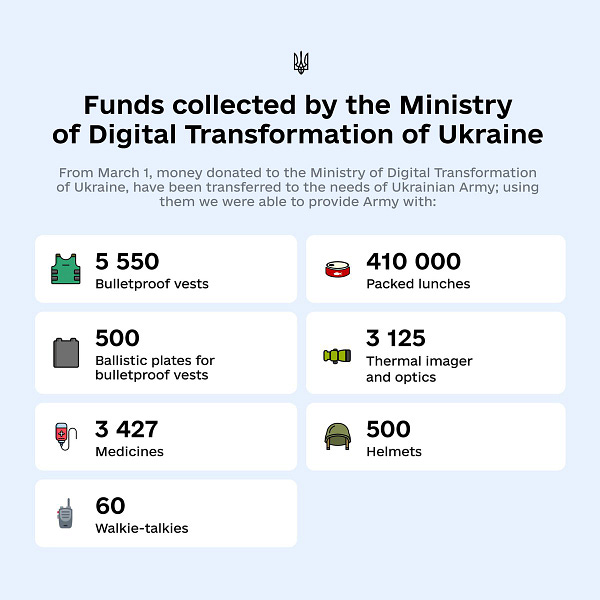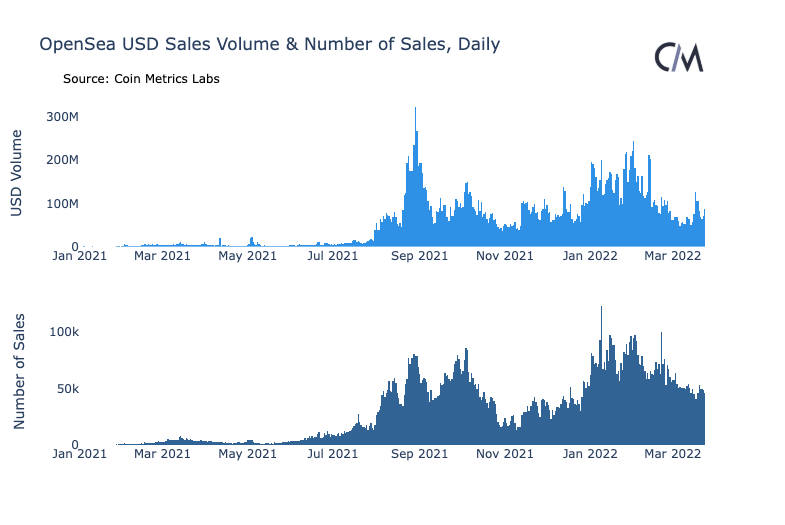Get the best data-driven crypto insights and analysis every week:
The State of the Network Q1 2022 Wrap-Up
By Kyle Waters and Nate Maddrey
In this special edition of State of the Network we take a data-driven look at crypto’s biggest
storylines of Q1, 2022.
Crypto on the World Stage
Since the beginning of Russia’s invasion of Ukraine in late February, crypto has been a vital lifeline for Ukraine. Within days of announcing a crypto-funding campaign, tens of millions of dollars worth of BTC, ETH, and other crypto assets quickly flowed from across the world to addresses controlled by Ukraine’s Ministry of Digital Transformation. As of the end of Q1, over $65M worth of crypto assets have now been donated.
Of the ~$66M received, over $57M has now moved out of the government’s crypto wallets. The government has bought everything from bulletproof vests to night vision goggles to prepared food packs with the funds. Many of these suppliers have even accepted crypto as payment.


Michael Chobanian, the head of Ukraine’s biggest crypto exchange KUNA, recently explained in an interview with Bloomberg why Bitcoin and other crypto assets’ fast time-to-settlement is a crucial property in urgent times of crisis:
“It takes 10 minutes for a Bitcoin block to close. And it takes about three days to do the same thing through the banking system… So three days vs. 10 minutes—therefore, we prefer crypto. And you can understand that time is money for my country right now. So if we can save a minute, it means that we can save at least someone’s life, so we are trying to speed up the process and crypto is helping us here.”
Many Ukrainians have also turned to crypto assets in the face of uncertainty and a devaluing local currency. BTC, ETH, stablecoins, and other crypto assets can be trivially self-custodied without third parties and are highly portable – properties that are of utmost importance when you may have to relocate unexpectedly.
Sources: Coin Metrics’ Reference Rates and Market Data Feed
In the tragic fog of an ongoing war, crypto infrastructure is proving to be a highly potent mechanism for mobilizing financial resources and empowering grassroots support. While most crypto asset prices might not have breached new all-time highs this quarter, crypto’s geopolitical relevance has arguably never been more apparent.
Macro Environment Grips Crypto Assets
In addition to geopolitical tension, a fast-changing macro environment in Q1 also impacted crypto assets and global financial markets at large. Against the backdrop of inflation in the US hitting its highest level since 1981 at 7.9% YoY in February, the Federal Reserve raised rates for the first time since 2018. The prospect of a more aggressive cycle of rate hikes weighed on riskier assets like high-growth tech stocks, which crypto assets more closely followed in Q1.
Bitcoin (BTC) finished the quarter in the green, up roughly 2% and returning back above $45K. BTC beat out most other crypto assets in Q1. Coin Metrics’ CMBI 10 Excluding Bitcoin (CMBI10EX), which measures the return of a basket of the next 10 largest crypto assets after BTC weighted by their free-float market caps, finished the quarter down about 11%. But most crypto asset’s underperformed gold on the quarter, which finished up ~5% amidst geopolitical uncertainty.
Source: Coin Metrics’ Formula Builder
Despite a late-quarter rally in March, prices for most major crypto assets were down to start 2022. The following chart shows quarterly and monthly returns for a selection of assets, ranked from highest quarterly return to lowest quarterly return.
Source: Coin Metrics’ Reference Rates
The quarter also reflected crypto’s changing geography. Relatively more BTC spot volume was concentrated during US market hours in Q1 2022 than in previous quarters.
Source: Coin Metrics’ Market Data Feed
Across the broader crypto-economy, the NFT market is showing signs of consolidation – as well as some cooling – after the market’s torrid pace of growth in 2021. Daily sales volume on OpenSea, the largest NFT marketplace on Ethereum, started rising to start the year, topping on February 1st at $245M, but then fell back to a sub-$100M per day pace in March. Daily sales followed a similar pattern.
But with Yuga Labs purchasing the rights to CryptoPunks and the launch of new marketplaces like LooksRare and adoption of aggregators like genie.xyz and gem.xyz, the NFT market is showing signs of maturation and continued development.
Growing Pains of a “Multichain” World
One of the most persistent challenges in the crypto ecosystem is scalability. In recent years, Ethereum has commanded the decentralized finance (DeFi) and NFT ecosystems. But it has also been a victim of its own success with fees rising to levels that often price out retail users. Even as the Ethereum ecosystem progresses with layer 2 (L2) technology to help scale the network, it’s becoming clear that there is demand for multiple blockchains that can optimize for different applications and types of users.
However, building infrastructure for users to interact across blockchains has been difficult. Token bridges have recently emerged as a popular tool to move crypto assets across multiple networks. Ethereum-linked bridges quickly amassed billions of dollars worth of assets in 2021 and became some of the largest ETH holders alongside centralized exchanges and DeFi protocols.
Token bridges’ underlying fragilities were unfortunately revealed in Q1 2022.
First, in early February, an attacker exploited a vulnerability found in the token bridge Wormhole initially leading to a loss of 120K wrapped ether (wETH, the ERC-20 compliant version of ether) worth about $325M at the time. The attacker was able to mint 120K of unbacked (wormhole) ETH on Solana, and redeem it for actual (wrapped) ETH tokens on Ethereum. However, less than a day later, Jump Crypto announced that they had re-collateralized the contract by depositing a fresh 120K wETH.
Then in late March, the bridge connecting Ethereum and Axie Infinity’s Ronin sidechain was exploited, with the attackers able to obtain the private keys to the bridge contract. A total of 173K wETH (~$600M) was drained from the contract in addition to ~$26M of USDC.
But despite the new attacks, lots of progress was made over the quarter in identifying bad actors from some of the most infamous hacks in the history of crypto. In early February, the US DOJ seized 94K BTC (worth about $3.6B at the time) and arrested two individuals allegedly directly linked to the 2016 hack involving the exchange Bitfinex. Later that month, author and crypto journalist Laura Shin released a detailed investigation identifying a suspect behind the 2016 hack of The DAO – the source of Ethereum’s 2016 hard fork.
Looking ahead, it will be important for the ecosystem to develop less trusted and more secure cross-chain infrastructure to lower the chances of an exploit. But advances in on-chain forensics also show that malicious actors are increasingly being tracked down and caught, which may help in deterring such acts in the first place.
Conclusion
From Ukraine to Turkey to other regions, real-world examples of crypto adoption are increasingly highlighting the promise of public blockchains. But there is still much to build as some of the fragilities of a still-nascent ecosystem are also becoming more apparent.
Ultimately, recent events are providing valuable information to policymakers and other industry participants that could lead to productive regulatory clarity and development. Q2 is bound to be full of new discussion and focus around crypto’s growing role across the globe.
Coin Metrics’ Q1 Updates
This quarter’s updates from the Coin Metrics team:
We released a new special report covering our adjusted transfer value metric, you can find the full report here.
We launched a new data and research-focused community on the web3 social media platform gm.xyz.
In January, we released a revamped Coin Metrics Python API client, which you can find more info about here. We also hosted an event walking through some of the basics of the Python API Client, check out our sample Jupyter notebook here.
As always, if you have any feedback or requests please let us know here.
Subscribe and Past Issues
Coin Metrics’ State of the Network, is an unbiased, weekly view of the crypto market informed by our own network (on-chain) and market data.
If you'd like to get State of the Network in your inbox, please subscribe here. You can see previous issues of State of the Network here.
Check out the Coin Metrics Blog for more in depth research and analysis.
© 2022 Coin Metrics Inc. All rights reserved. Redistribution is not permitted without consent. This newsletter does not constitute investment advice and is for informational purposes only and you should not make an investment decision on the basis of this information. The newsletter is provided “as is” and Coin Metrics will not be liable for any loss or damage resulting from information obtained from the newsletter.








